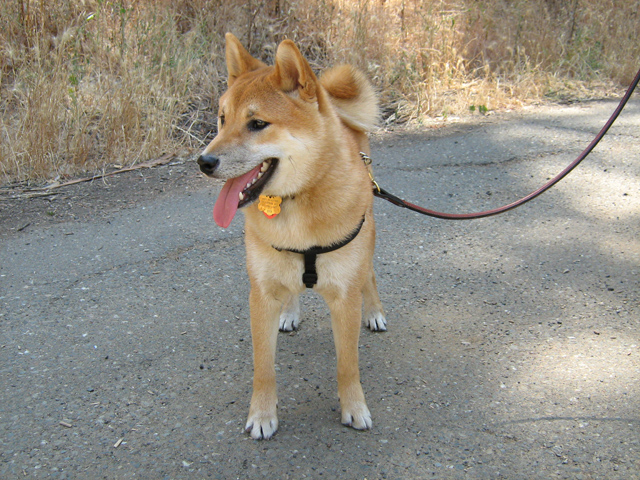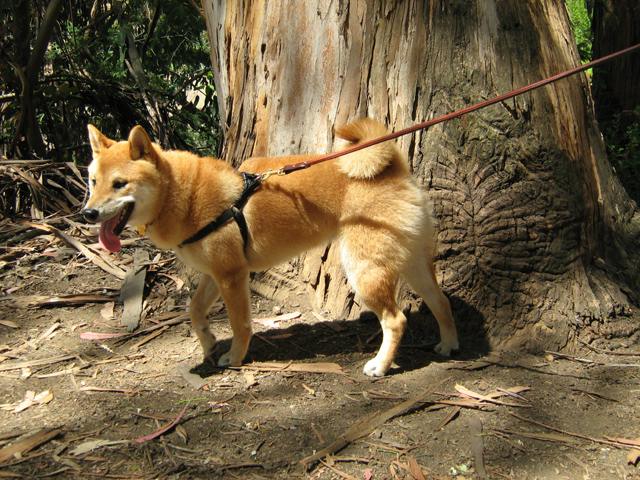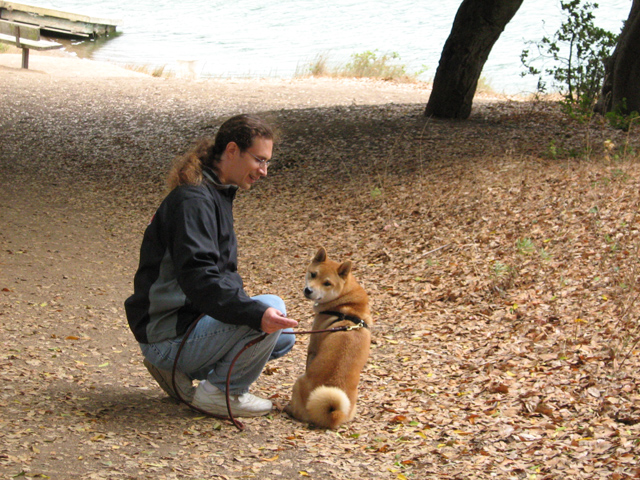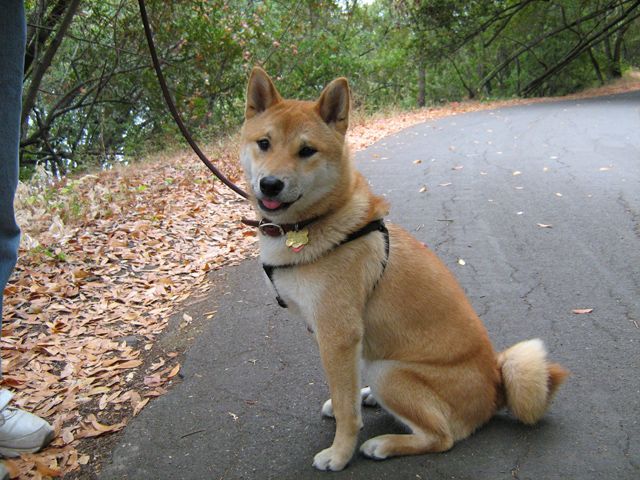Leash training a dog, is effectively achieved by teaching him one simple fact-
Instead, walking properly next to us, is the quickest way to get to his destination.
To teach this lesson, it is important NOT to reward our dog for pulling.
Do not let our dog drag us along, and do not pet or give him any affection while he is pulling. Teach him to walk on a loose leash first, before attempting to walk him close to us in a heel position.

Here are some leash training techniques:
1. Red-Light, Green-Light

A simple way to leash train a dog and teach him not to pull, is to …
- Stop walking when the leash is taut, and
- Start moving again when the leash is loose.
We do not even need to say anything to our dog. Through our actions, he will figure out the rules of the game.
When we stop, some dogs may decide to roam around and smell whatever is available in the environment. To stop this, I usually shorten the leash and bring my dog in next to me. This does a better job at limiting his freedom, which makes this technique more effective.
In addition, I only start moving again after my dog does a Sit next to me. I use a shorter lead in the beginning, then slowly lengthen it if my dog walks nicely, and without pulling. By changing the length of the lead, we can control the amount of freedom our dog has, and further motivate him not to pull.
Initially, we may need to stop very frequently, so be ready for really short walks. However, it is important to be patient and absolutely consistent with the stop rule. Otherwise, our dog will learn that if he pulls enough times, we will give-in and let him go wherever he wants. This encourages him to pull more in the future.
2. 180 Degree Turn
Depending on the age and temperament of our dog, frequent hard stops may cause him to get frustrated. Too much pent-up frustration can make a dog act out in other ways, for example, he may resort to leash biting.
If we are training an easily frustrated or excitable dog, it may be more effective to use the 180-turn technique.
As soon as our dog starts to pull, quickly turn around and start walking in the opposite direction. In this way, the dog can release his pent-up energy, because he is still doing something physical – walking. At the same time, he learns that when he pulls, he just gets farther away from his desired destination.
If our dog walks properly on a loose leash for a few seconds, we can mark him for his good behavior (Good), turn back, and resume our walk. If he starts pulling again, it is fine to walk back and forth on the same stretch of ground until he learns not to pull.

3. Hand Targeting


Start by training the dog to target our hand at home.
First, I put some dog treats in my hand, and make sure my dog knows that it is there. Then, I put my hand close to his muzzle and say Nose. As soon as my dog touches my hand with his nose, I mark him (Yes) and treat him. I repeat this exercise until I am confident that he has learned the command.
Next, I move a few steps away, put my hand out in the same gesture, and say Nose. When he moves toward me and touches my hand, I mark the behavior (Yes) and treat. I keep repeating this inside the house, then continue the exercise in the backyard.
Once we are comfortable doing this in the backyard, we can try using this technique outside.
If the dog pulls, non-mark him (Uh-oh), get him to do a Sit, re-target him on our hand, and continue the leash training session.
In this way, our dog learns that pulling is inappropriate, and walking close to us will get him affection and treats. We can treat less often, and slowly phase out the treats altogether, once our dog learns to walk calmly by our side.

4. Collar Correction/ Leash Correction/ Leash Jerk
The most common aversive technique for leash training a dog, is to perform collar corrections (also called leash corrections or leash jerks).
A collar correction must be a quick jerk of the leash. There is only tension for an extremely short amount of time (a quarter-second or less), and then the leash should be loose again. Most people tend to do tugs rather than jerks, which will do little in training the dog.
Tugs may actually exacerbate the situation, because it places continuous tension on the leash. This tension may cause the dog to get tense and frustrated.
We must also be properly positioned for the collar correction, so that the force is always to the side rather than directly back. Jerking to the back may encourage the dog to lunge forward to oppose the force, thus causing him to pull even more.
To work well in leash training, collar corrections must be executed with the proper force, proper timing, and proper redirection. This is necessary so that the dog learns that pulling is wrong, without becoming afraid of his surroundings, or distrustful of his owner.
If not properly implemented, a collar correction may backfire and cause additional behavioral problems including dog aggression.
Only use collar corrections as a last resort. Only use collar corrections under the direction of an experienced professional trainer.

How to Stop Dog Pulling
Some dogs and some dog breeds will pull more than others. For example, I have two Siberian Huskies, and they both pull more than my Shiba Inu, because Huskies are bred to pull. However, by starting training early and being very consistent, even Huskies can be trained to walk at a measured pace by our side.
In the beginning, I leash train my dog in the backyard, where there are very few distractions. Once my dog is comfortable walking there without pulling, I move on to more quiet areas of the neighborhood. Another alternative is to walk during off-peak hours, where there are fewer people and dogs around.
By carefully choosing our training environments, we can set our dog up for success, and help build his confidence. Once he is comfortable walking in a given area, we can slowly increase the level of distraction.
Before we know it, we will be enjoying a wonderful neighborhood walk with our dog! 😀
Hello! My boyfriend just recently bought me a shiba inu puppy! I am absolutely in love with him. He’s currently 4 months and I’ve read all of your articles on how to train and take care of him. I do have a small problem walking him on leash. He walks beside me majority of the time however he would always go and smell everything he sees! I often wait but I want to keep the walk consistent so I tug on him a little. Sometimes towards the end of our walks I have to drag him back inside the house because he keeps smelling and picking up everything he sees! Is that normal? How would I go about fixing this? I don’t want to keep pulling on his harness everytime I want him to go. I try to calmly tell him,” okay! Shinobi time to go. Let’s go boy” but if something sparks his interest he just smells and investigates it. Any help would be great! Thank you!!
Congratulations on your Shiba puppy!
In terms of moving, this rule helps with Sephy-
If I want to keep moving and don’t want to stop, then I pick up the pace, play the Find-It game, and make things interesting so that he will follow.
More on what I do.
My 6 month old puppy does pretty well on the leash until we turn around and head fro home. He’s so excited that it’s a bee line to the house. I’ve tried the stop, 180, etc. but we get no where. It’s right back to pulling towards home. He’s also a very anxious dog and it’s hard to even get him to come out the front door to go for a walk. Any suggestions?
My Husky puppy Lara was also a bit uncertain on walks in the beginning. Some things that helped with Lara-
1. I start with very short but frequent walks that are close to home. Lara is a lot more confident closer to home. The more trips we take outside, the more routine it becomes.
2. I make trips outside very very positive. I reward her very well, I play games with her to distract her, and we stop a lot to smell the roses. I let Lara set the pace and when she wants to go home, we go home.
3. Lara was afraid of certain loud noises at the beginning, e.g. garbage truck, people on skateboards. To help her with this, I did sound desensitization exercises with her at home.
The more positive and successful walks we had, the more confident Lara became, and soon she wanted to keep going and going. 😀
Also note that puppies go through certain fear periods.
http://www.berkeleyhumane.org/wp-content/uploads/galleries/CriticalFear.pdf
http://ice.ucdavis.edu/~robyn/Korina/Criticalperiodsinpuppydevelopment.html
Hope this helps. Big hugs to puppy!
Hey there, great blog. Question for you: I have a 13 week old Siberian named Juno (female). She is excellent and we have worked hard at training the last month. We have been working for 2 weeks on leash training and walks. We pretty much always have her on a leash in the house, and she does well in our inside leash training, coming with kibble enticement and she is very used to having a leash on. When we walk her it is another story. She will walk perfectly for 2-5 minutes and then she just sits. I can entice her to come to me with a hand target and kibble. She gets the kibble and a positive verbal reward and then sits again. She seems to be absorbing the outside world, she is looking around, smelling the air and seems quite happy. Sometimes after 20-30 seconds she will come as I am squatting in front of her with no leash tension and calling her in a calm voice. Sometimes she won’t budge. In the house she doesn’t do this. It is as if the outside distractions are too much. But we have been working on this for 3 weeks, up to 4-5 times per day and no improvement! I don’t get it. Do you have any advice? When she IS walking for the few minutes that it happens on a lead, she seems super happy. Sometimes she even lays down in the grass with a goofy/relaxed demeanour. Help!
Thanks
Juno’s Dad
She is still really young, so she may be uncertain about the outside. I didn’t really walk Sephy or Lara around the neighborhood until after they were fully vaccinated. I was mainly worried that they would pick something up from other dogs, dog poop, etc.
http://www.dogforums.com/first-time-dog-owner/14886-when-start-walking-puppy.html
http://www.gentledoberman.com/forums/doberman-pinscher-discussion/doberman-health/why-you-shouldnt-walk-until-your-puppy-fully-vac
http://www.yorkietalk.com/forums/general-yorkshire-terrier-discussion/180134-can-puppy-start-walking-without-shots.html
For socialization, we did puppy classes. I made sure that they checked for vaccination records for all the puppies, so there is much less risk.
When I first started walking Lara we would just walk around close to the house. She was still getting familiar with everything, so I just focused on making walk time very positive. As she gained more confidence, she would explore a little bit farther and so on. Sometimes I would play her favorite games with her, to distract her from the environment and keep things positive. I think that especially in the beginning, successful positive walks are most important, so we went at a pace that she was comfortable with.
Puppies also have different fear periods so that is another thing to look-out for.
Big hugs to Juno! Please post us some picture links when you have the time. 😀
I have a 2 1/2 year old labrador retriver he is trained by myself and follows basic instructions.When it comes to walking him out he forgets everything would pull literally drag me at times especially if he sees a family member coming or anither animal.I have tried couple of techniques but they did not work,including red green technique(my b coz i gave up too soon).also i tried walking him without leash couple of times,was shocked to see he ran away so fast.He would see me from far and run again and i finally caught him when he entered a under construction house.He even run away when gate is left open .now he is never off leash,is it fine or cruel to do so.also i love him so much why he runs away.plz suggest how should all this be solved.
I think your instincts are right. It is not safe for a dog to be off-leash unless he has very good recall. Even then, I would *not* let my dog off-leash in places that are close to roads and traffic, or that may be dangerous due to construction or other reasons.
Here is a good list of recall training techniques (training a dog to come when called) from the ASPCA.
In terms of curbing excitement towards people and other dogs, I do desensitization and counter conditioning exercises.
In addition, consistency and patience are very important in dog training. I am not a patient person by nature, but I have learned to be much more so with my dogs, because it is very important. I also try to be calm and consistent, because that is the best way to communicate with them and to gain their trust.
I also follow the Nothing in Life is Free program with all of my dogs.
Here is more on how I trained my Husky.
Here is more on how dogs learn.
Hello
I have Siberian husky who is 2 years old. And we are practicing Red-Light, Green-Light Technics. We were doing that technique in quiet place for a while so we are going now on the streets. But when we are going out of yard he is quite excited so I wait until he calms down. But usually that takes quite long time and when he lays down and become little bit calmer I still see his tail is excited and he usually doing screechy voices what is quite annoying and making me only nervous. How long do I have to wait that he becomes submissive and what is best way to make him submissive. Also we have big problems when he sees other dogs. He becomes very excited and started to be very dominate.
Hope you will give me some tips how to deal with those kind of problems.
Thank you
What helps with my dog, is to first practice walking outside in a more quiet environment. My old neighborhood was very busy with lots of cars, people, and other dogs. Therefore, in the beginning we would drive to a more quiet area to practice walking. This allowed us to do exercises outside, but not have too many distractions.
When a dog gets to a new environment, everything is new and exciting. If there is too much happening outside, then it will be really difficult for him to calm down.
It really helped for us to take things one small step at a time. In this way, both Sephy and I have more success, we build more confidence, and we build greater trust.
My dog is also more calm when he has other outlets for his hyper energy. If I can drain some of his excited energy before the training session, then he is more calm during our walk. I also follow the Nothing in Life is Free program with all of my dogs.
To help my dog stay calm in the presence of other dogs, I did dog-to-dog desensitization exercises.
Hi,
I’ve been walking a 2 year old staffordshire terrier bitch, who has had very little training. I started walking her, as she had pulled her elderly owner over and broke her arm. She pulls like anything and I’ve been using the stop and wait for her to come to me tactic, which works most of the time but she does sometimes sniff around or only come part of the way back. She has got better at not pulling, but i’m not sure i’m using the right tactic which may be making me less consistent. I’ve tried the 180 and that worked initially but she has now started jumping up and trying to nip when we change direction. How do I tackle this? She quite strong and this nipping thing is quite intimidating… She also doesn’t seem to be interested in food or toys but is a very sniffy dog, can i use this to train her?
Yeah, my Huskies also love to pull and they love to sniff. Therefore, when I stop, I shorten the leash and bring them in close to me. In this way, I briefly take away their sniff freedom. They quickly learn that-
Pulling = We stop, don’t get to go anywhere, and don’t get to sniff,
No-pulling = Get sniff freedom, and get to explore.
When I walk, I adjust the length of the leash to suit my dog’s behavior. A shorter leash gives me more control and gives my dog less freedom. A longer leash gives me less control, and gives my dog more freedom.
I usually start with a shorter lead. If my dog walks well, then I very slowly give him more freedom. If he starts pulling, then we stop. When I start walking again, I go back to the shorter lead and so on. In this way, I reward good walking behavior with more freedom, and discourage bad walking behavior with more control.
As for leash biting, here are some of my leash biting experiences with my Shiba Inu.
Hello! My second time looking to this site for help…My four month old husky/shepard mix has developed a very strange habit. I started taking him off leash in the woods behind my house to see how he would do, and to my surprise he stuck right with me..always came when I called. Would even repsond to things like”stop” or “leave it” which I thought was incredible for a dog of his age. Alas, all of the sudden he has started to ignore the direction Im walking In. Now, he doesnt bolt at anything or even run really..he just sort of trots in the opposite direction, or simply sits and stares at me..like he disagrees with the direction Im taking! haha. A few times I have caught him either running all the way back to my car , and sitting under it..( When were at our local park) or running all the way back to my house, from the woods behind us. Its very peculiar. I realize after reading I should definetly get him better on leash training before I can expect him to be obedient off, but are there any other tips/odd cases for/of this type of behavior? Hes very well behaved other wise..Sits, lays down, bite inhibition is very good. Sits , lays down, and stays at every meal time before feeding. Is pretty well house broken, and very loveable and friendly. HELPPPPP!
Also, I always make sure he is fed, and I bring water with me…having trouble uploading a picture, but ill post one soon : )
Yeah, my young Husky Lara, is the same way. She is more cautious when we go to new places – it is a good survival trait. 😀
When I take her to new places during our walks, she will usually want to explore only a small area at first, and then we would go home. The next time, we would explore a slightly larger area and so on. I let her set the pace and make sure she has a positive experience. The more successful explorations we have, the more confident she becomes, and the more balanced (less fearful) she will be when she gets older.
Young puppies also have different “fear periods” so it is important to carefully manage what we expose them to, and to make sure that they learn the right things.
A bit more on what I do to socialize my Huskies to new things.
This article from the ASPCA also has a good list of recall training techniques-
http://www.aspca.org/pet-care/virtual-pet-behaviorist/dog-behavior/teaching-your-dog-come-when-called
Big hugs to your Husky/Shepherd boy! He sounds like a sweetie.
Very helpful! Thank you so much, Love this site! HE is a big sweet heart. : ) haha
Opps, sorry about that. Corrected my mistake. 😀
Would definitely love to see him so please send me some picture links when you can.
Pictures of Jax man! https://www.facebook.com/sean.quinn.963/media_set?set=a.10151578149704895.1073741828.513079894&type=3
He is adorable! He has Husky markings but in GSD colors. I also like the pink nose. Lara also had a pink nose when she was a puppy. And the floppy puppy ears too.
I also enjoyed the New Mexico pictures. Shadow looks good!
Thanks for the pictures and hugs to your pups!
haha thanks, Yes he is a beautiful little guy. Shadow is wonderful too! Do you guys have a facebook page? Glad you enjoyed the pictures : )
Hi! I have a Yorkshire Terrier who just turned 1. Every time I took him on walks he would start tugging on the leash until he was choking. He kept on making some of noise with his throat that sounds sort of like snorting… I was wondering if the sounds have to do with the type of collar I’m using? Or the way I walk him?
What collar are you using? What type of leash? How long a leash? How do you walk him?
Have you tried using a harness? That does not choke the dog even when he pulls. Here is more on harnesses and other leash training equipment.
Hi i have a american staffy 1 yrs old and everytime i take him for a walk he trys to pull me every direction to smell everything also he keeps pulling on the leash everytime another dog big or small goes past him he only wants to play but i dont want him to how can i get him to stop
I use the red-light/green-light technique and the 180 turn around technique with my dogs. I describe what I do in greater detail in the article above.
howdy, mah name is kaitlyin I have an husky her name is luna every time I take her for a walk she tries to pull me and when I stop she still tries to pull me how can I make her stop
What type of leash are you using? How big is Luna?
When my Husky pulls, I stop walking and also shorten the leash. In this way, she has to stay close to me and doesn’t get to explore while we are in a stop position. Consistency, repetition, and timing are all very important in leash training so I make sure to stop *every time* the leash is taut and I do not start again until my dog is calm and in a Sit position. I also start leash training in a more low stimulus environment (where there are fewer distractions). Initially, I have shorter but more frequent walks, so that I can keep my dogs attention, stay calm myself, and keep things consistent.
I use a 6 foot leather leash so that I can easily and quickly change the length of the leash as needed. It also gives me much better control of my dog compared to a flexi-leash.